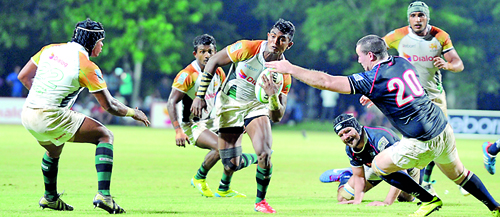The competition amongst contesting teams was like a“doosra”
View(s):The rugby world is spinning differently so that it will enhance the competition among participating teams. Some tend to believe it was a last minute “doosra.” Sri Lanka Rugby has suddenly caught the scenario of performance banding of the IRB in their picture. The fact that the ball will be allowed to spin was published a few years ago: probably as old as five years.
IRB looks at the game as High Performance, Performance and Development. Unions / teams are classified based on “their development status and record on the international stage”. From the Asian teams Japan falls to the High Performance Group that includes 18 Nations. These include Six Nations, The four from Rugby Championship, six of the Pacific Nations Cup and Georgia and Rumania.
The Performance Group where increased funding is focused includes Namibia, Portugal, Spain and Uruguay. The rest are in the

Sri Lanka did well to hold Hong Kong 41-10 in last weekend’s A5N game - File pic
Development Group which also includes a target group, India, China, Germany and Mexico. This is because of the potential to increase numbers in interest.
Following a similar plan for Asia the IRB bands Japan, Hong Kong and Korea as the High Performance teams in Asia and Sri Lanka falls within the performance group. It is this rationale that follows the ARFU tournament for 2105 to be limited to three. Sri Lanka which is in the Performance bracket in Asia has a clear development target to achieve in order to enter the next phase. Reading which a sine qua non for improvement is, as mentioned by a rugby stalwart of the SLRFU, one factor that is against us as the knowledge of the proposed systems was lacking. These performance bands did not come out all of a sudden as an immediate thought that came into mind, while performing the morning ablutions and put into operation. The expectation is around 5 years old and countries and regions structured their domestic system towards High Performance which is mentioned several times.
It is worth looking at the USA Strategic Plan 2013-15 which is an example I picked out of many such documents. This Plan spells out the performance indicators through areas of Leadership, Development, Performance Marketing and Communications and Revenue Generation.
Performance: “Invest resources that support the development of elite pathways for men and women that drive the achievement of sustained competitive excellence for all our national teams at World Cups, Pan American Games and Olympics”.
Revenue generation: “Diversify and grow revenue streams with the ultimate goal of supporting all high performance programs and national teams from non-membership dues.”
A sub item under development refers to Math Officials and listed as:
* Achieve stated participation goals for each level of trainings as agreed in the Annual Operating Plan.
*Maintain a minimum of 75 IRB educators via re-certification and annual educator trainings.
*Annually retain 80% of registered and certified match officials.
* A minimum of four male and four female international appointments annually.
* At least one male and one female on the IRB 7s circuit every year.
I picked the match official performance indicator as this is a perennial issue that crops up when we come to crucial games whether it is at the club school and has infiltrated to those watching international games too with the same blinkers on
What is needed is to look strategically at the development of the game without spending too much time with a narrow focus of the club school and or my region. These are operating level function which should be result from the objectives and the strategies arising from the plan. Otherwise a lot of time wasted on the issues of clubs and or individuals and it ends with ‘No Action Talk Only’.
Sri Lanka played against Hong Kong and according to pundits of the game we did well to hold them to the score and also showed promise by coming back strongly in the second half. Others have reminded me of the number of players that have come from the development programme from Piliyandala, Kurunegala, Anurdhapura etc. They also point out that these boys were inducted to better rugby playing schools and have now risen in their rugby career. The crux also is to highlight that people accuse schools of importing players but because of that factor they have been able to attain National Standards. Agreed, and there is no argument about that. My contention is that all this should fit into an overall plan.
It is true that these players came through the system; but looking from a national perspective can we look at why we could not hold the scrum or win a line out? It could be purely a technical issue that has not been addressed and carried to the National level. These are issues that need to be addressed when we have to plan to move from the performance group to the High Performance Group in Asia.
Most of the players of the Hong Kong side had played in the Under-20 group a few years ago where most members of the Lanka team too played against them. Some of them who played in 2007 and 2012 are in the National team. In 2007 Sri Lanka lost 0-6, while Hong Kong youth have achieved better performance while Sri Lanka has stayed at the same level in playing skills.
The need is to present more than before development programmes to grow the game of rugby at all levels across Sri Lanka in order to develop the elite team. High performance pathways for aspiring players whose goal is to represent the Tuskers at Sevens or Fifteen’s – men, women and juniors.
Vimal Perera is a former Rugby
Referee, coach and Accredited Referees Evaluator IRB


